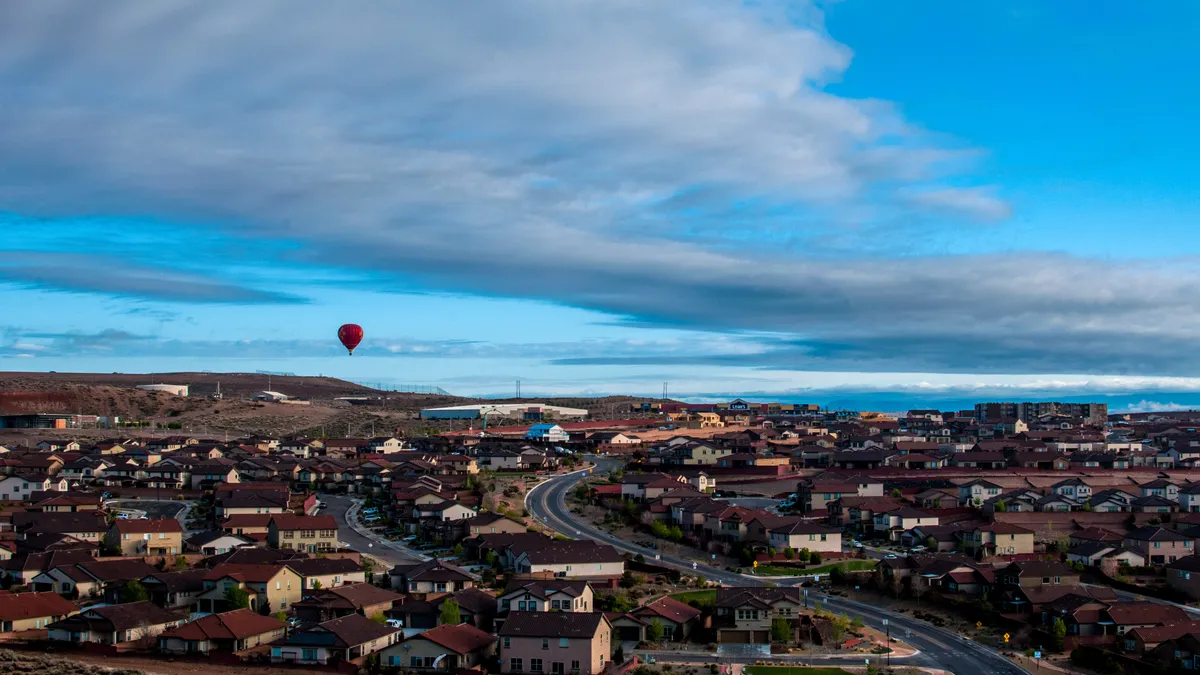Dive Brief:
- Albuquerque, NM broke ground Thursday on a 50-megawatt solar field that city officials believe will help it make significant progress towards its goal of using 100% renewable energy.
- The solar array will be located on 500 acres of tribal land owned by the Jicarilla Apache Nation in Rio Arriba County, NM, and developed through a partnership with electric utility Public Service Company of New Mexico (PNM). It aims to power more than 50% of municipal operations and is projected to help the city reach 88% renewable energy use by the end of 2021 alongside its on-site solar, electric vehicle (EV) infrastructure, energy efficiency and new buildings. The site is expected to produce enough clean energy to power around 16,000 homes per year.
- It comes as part of a partnership with PNM under its Solar Direct program, a voluntary scheme where large electric customers can subscribe to receive solar electricity for a minimum of 15 years, protecting them from fluctuating energy costs. The solar field is expected to begin operating in June 2021.
Dive Insight:
Cities looking to expand their renewable energy portfolios are increasingly turning to solar. Earlier this year, research from Environment America found that 50 US cities have more than doubled their total installed solar photovoltaic (PV) capacity since 2013, and there are several ambitious solar projects elsewhere in the country. Cincinnati plans to build the nation’s largest city-led solar array, while Charlotte, NC became the most populous US city to acquire large-scale solar through a green tariff when partnering with local utility Duke Energy.
The solar field is a large part of the city's commitment to reducing its greenhouse gas emissions by 80% by 2050, in addition to a broader move in New Mexico away from relying on fossil fuel production, according to Albuquerque's head of sustainability Kelsey Rader. Another 50-megawatt solar field is being installed to generate power that would be lost in the expected 2022 retirement of the San Juan Generating Station in San Juan County, NM.
Rader said it is key for cities to take every possible opportunity to invest in clean energy.
"To be able to have that extra push that comes from a voluntary program that we're able to work out with the local utility, I think it's just a really great success story for how cities can get to that place where you're investing in your local small scale renewables," Rader said.
And it follows the Jicarilla Apache Nation's efforts to control its own energy. In 2014, the tribe established the Jicarilla Apache Nation Power Authority (JANPA), initially to provide energy to the community in Dulce, NM. This solar farm will be built on the tribe’s land, a move that Jicarilla Apache Nation President Edward Velarde said at the ground-breaking ceremony would provide two megawatts of renewable energy back to the community.
"With the nation's forward-thinking exercise of self-determination, it has enabled us to enter the renewable energy market by building a solar farm on our land," Velarde said.
Rader said with tribal nations increasingly moving away from a reliance on oil, gas and coal and able to make more decisions about their energy consumption, it is crucial for partners like city governments and utilities to work hard to ensure a "just transition."
"There is going to be a lot of attention that needs to be paid in terms of how we are asking our tribal folks, asking our rural lands to shift from coal, shift from oil and gas over to solar and wind and paying attention to what the economic impacts are going to be," Rader said. "How are we being supportive of a process? How are we being good actors in working with tribes, and especially, I think that really centers on acknowledging tribal sovereignty."
For the city, Rader said this solar field's impact on municipal operations and emissions should be so great that local leaders can start to focus on other ways to reduce emissions, like in the buildings and transportation sectors, which are the biggest generators of pollution.
"It's nice to feel like we can make serious progress in one of these really big sectors to be able to then continue to turn our attention and put our efforts into places where we can also make progress and some other difficult areas as well," Rader said.












